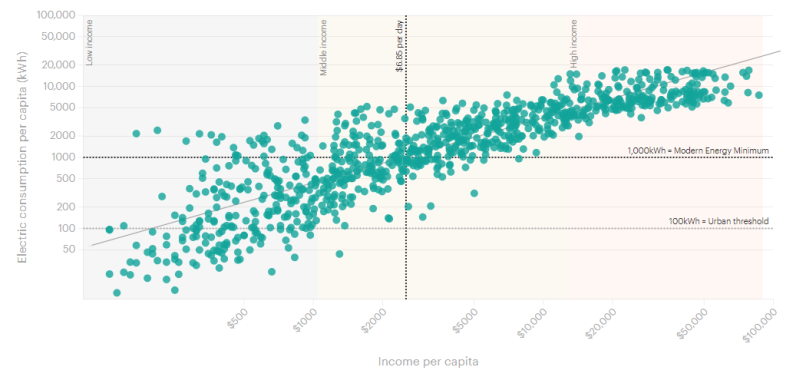Expanding modern cooling services with energy efficiency (SDG7.3)
 |
Contents See also: |
- Energy efficiency expands the package of cooling services for households with low income and low tiers of electricity supply.
- In high-impact countries, with business-as-usual (BAU) efficiency, refrigerators-freezers and air conditioners (AC) risk remaining too energy intensive for millions of low-income households at risk. Efficiency standards (MEPS) could make 1.07 billion appliances compatible with the electricity services of households, including +40 percent refrigerators-freezers and +16 percent AC units compared to business-as-usual.
Access to an adequate electricity supply is necessary but not sufficient for operating cooling appliances. Basic access as defined by SDG7.1 is largely not enough to power a bundle of energy services that include cooling devices. According to the World Bank Energy Sector Management Assistance Program’s (ESMAP’s) Multi-Tier Framework, a minimum of Tier 2 electricity services are required to support a fan, and Tier 4 services are required in order to power more energy-intensive appliances such as refrigerators and freezers.
The Modern Energy Minimum framework, recognizing a correlation between growing incomes and electricity consumption, estimates a threshold of approximately 1000 kWh annual consumption per capita, of which at least 300 kWh is available at the household level — as necessary to meet basic needs — including access to cooling — while also supporting growth in living standards and daily incomes above USD 6.85 per capita (Figure 2). [1]
Within the range of available electricity supply, energy efficiency is a fundamental and often under-recognized catalyzer of access to energy services: more efficient products can be powered by lower tiers of electricity access, hence expanding the package of services available to households and for productive uses. In the case of off-grid cooling services, CLASP and Sustainable Energy for All (SEforALL) [2] found that the best available off-grid cooling technologies are more compatible with lower tiers of electricity services than previously expected, as efficient off-grid refrigerators can operate with Tier 2 electricity supply.
Similarly, the Electrifying Economies benchmark by RMI, SEforALL and The Rockefeller Foundation has shown that high energy-efficiency appliances could double the service package available to rural households with an electricity consumption of 200–300 kWh per year. [3] Building on these concepts, this analysis investigates the effect of energy efficiency on the cooling services that could be available to households with estimated medium and low access to cooling risk in 2030.
Using the correlation between income and electricity consumption that informs the Modern Energy Minimum, it estimates the number of cooling appliances — refrigerator-freezers, ceiling and portable fans, and air conditioners — that could be compatible with the electricity consumption levels of households at risk under different energy-efficiency scenarios.
Figure 2. Relationship between levels of electricity consumption and income

Today, the ability of low-income households to own refrigerators is hindered by both their costs and their energy intensity. In 2018, only 17 percent of households in Sub-Saharan Africa and 38 percent of those in India owned a refrigerator. [4] [5] Ownership of refrigerators grows closely with electrification, suggesting that households with access to electricity tend to purchase a refrigerator if it is affordable. [6]
United for Efficiency has projected that the total number of refrigerators in use in 150 developing countries and emerging economies could reach almost 1.8 billion units by 2030. [7] In high-impact countries, with BAU appliance efficiency, almost 340 million refrigerator-freezers could be compatible with the assumed levels of electricity consumption of 51 percent of households at medium and low risk (Figure 3).
Introducing MEPS would drive reductions in the annual electricity consumption of cooling appliances, making an additional 133 million efficient refrigerator-freezers potentially viable, and reaching a total of 470 million units compatible for 71 percent of households at medium and low risk. In particular, under BAU efficiency, refrigerator-freezers remain largely incompatible with low levels of electricity consumption by the poorest households in the 54 high-impact countries, with the exception of China. A market shift to efficient units could extend the viability of refrigerator-freezers for almost 75 million additional poor households in 40 countries.
A similar trend is found for air-conditioning (AC), although its higher energy intensity further restricts its compatibility with low levels of power supply. In 2030, with BAU appliance efficiency, over 93 million AC units could be a viable option for just 14 percent of all households at low and medium risk in high-impact countries to meet thermal comfort needs within assumed electricity supply available.
The introduction of MEPS could increase this number by an additional 15 million energy-efficient AC units. It is important to note that pairing MEPS with affordability measures such as subsidies, rebates or access to credit may remain necessary in order to make efficient refrigerators and air conditioners accessible to populations at risk, as costs are often prohibitive for low-income populations. In the long term, studies in various countries have shown that prices of efficient refrigerators have fallen consistently following improvements in efficiency. [7] [8] [9]
Fans, in contrast, are already in wide use in many high-impact countries. In India, 90 percent of households, including low-income ones, own fans. [10] In high-impact countries, even with BAU efficiency, portable and ceiling fans are compatible with the electricity supply available to almost all households at medium and low risk, with 490 million units possibly viable in 2030. At the same time, fans often form the bulk of households’ electricity consumption, and a substantial efficiency gap exists between typical fans in use and best-available technologies on the market. Hence, stringent MEPS in line with international best practices will play a crucial role in reducing the energy demand associated with this large cohort of appliances by 2030, and freeing up households’ resources, both in terms of electricity and disposable income.
It is important to note that opportunities to address a latent demand for thermal comfort also arise from improving energy efficiency for other household uses — food preparation, cleaning and entertainment — allowing for redistribution and a more productive use of the available electricity supply. [9]
Figure 3. Estimated number of cooling technology units compatible with electricity services in households at risk in 2030
Notes and references
[1] Energy for Growth Hub (2020), The Modern Energy Minimum: The case for a new global electricity consumption threshold (link); Rockefeller Foundation (2021), Why 2 billion people remain locked out of the global economy (link)
[2] SEforALL and CLASP (2021), Raising Ambition for Off-Grid Cooling Appliances (link)
[3] RMI, SEforALL, Rockefeller Foundation, Electrifying Economies (link)
[4] Efficiency for Access (2021), Appliance Data Trends (link)
[5] The Hindu (2022), Data | How many Indians own a fridge, AC or a washing machine: A State-wise split (link)
[6] McNeil at al. (2010), Modelling diffusion of electrical appliances in the residential sector, Energy and Buildings, Vol. 42, Issue 6 (link)
[7] United for Efficiency (2017), Accelerating the Global Adoption of Climate-Friendly and Energy-Efficient Refrigerators (link)
[8] Efficiency for Access (2021), Appliance Data Trends (link)
[9] Poblete-Cazenave (2021), Global scenarios of household access to modern energy services under climate mitigation policy (link)
[10] Aggarwal and Agrawal (2022), Business Model for Scaling up Super-Efficient Appliances: A Deep Dive on Ceiling Fans in India (link)

